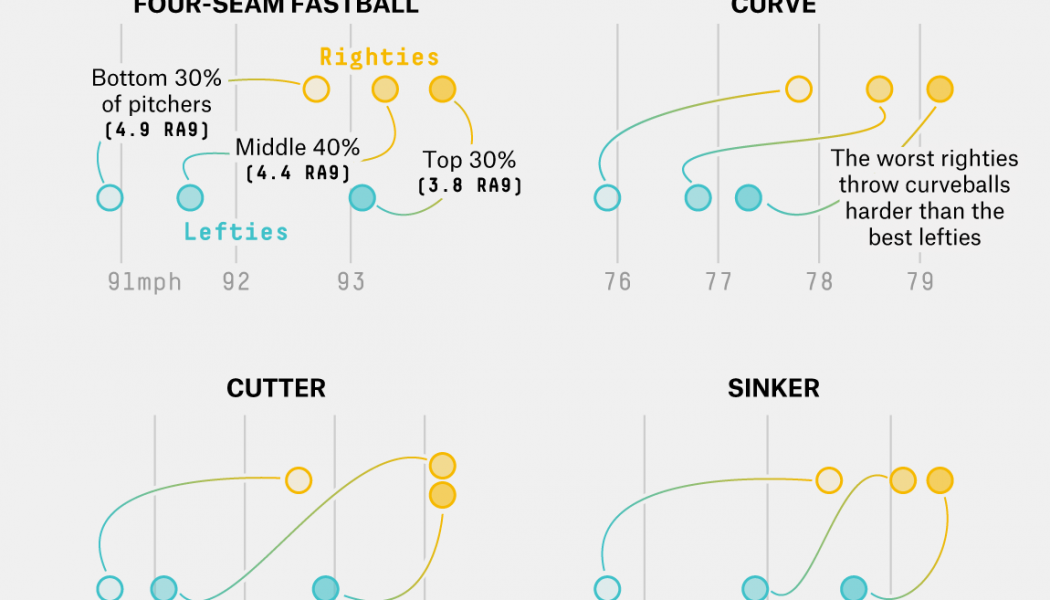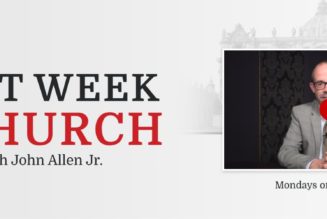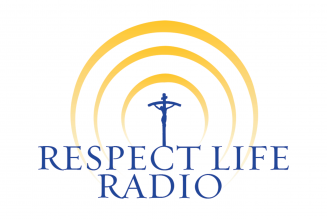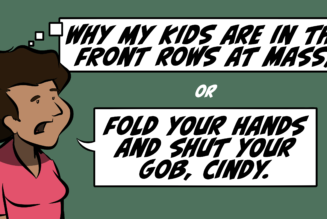Left-handed pitching has long been one of the most prized commodities in professional baseball. Teams strive to obtain lefty pitchers, and southpaws recognize their competitive edge. Two-sport athlete Tom Glavine explained his career choice this way: “I love both sports, but the deciding factor was, being a left-handed pitcher, I had a huge advantage in baseball because of that, and I didn’t have that type of advantage in hockey.” Even a century ago, Tris Speaker expressed the sport’s reverence for southpaws — if falling short as a trade analyst — when he reportedly opined that “taking the best left-handed pitcher in baseball and converting him into a right fielder is one of the dumbest things I ever heard.”<a class="espn-footnote-link" data-footnote-id="1" href="https://fivethirtyeight.com/features/what-really-gives-left-handed-pitchers-their-edge/#fn-1" data-footnote-content="
Of course, Speaker was talking about the immortal Babe Ruth.
“>1
MLB rosters reflect this preference for lefties today. Although just 10 percent of American males throw with their left hand, fully 28 percent of innings thrown by MLB pitchers in the past decade<a class="espn-footnote-link" data-footnote-id="2" href="https://fivethirtyeight.com/features/what-really-gives-left-handed-pitchers-their-edge/#fn-2" data-footnote-content="
From 2010 through 2019.
“>2 — and 29 percent of starts — came from the left side. Remarkably, lefty pitchers make it to the big leagues about three times as frequently as righties, given their share of the general population. What accounts for this huge surplus of southpaws?
The traditional explanation has pinned responsibility on baseball’s platoon advantage, in which hitters perform better in opposite-hand matchups while pitchers have the edge in same-handed contests. Since left-handed hitters have the platoon edge much more often than right-handed hitters, they have an edge in the competition for MLB jobs and end up overrepresented on offense. In response, the story goes, teams then stock up on left-handed pitchers to counter the advantage offenses gain from their excess of left-handed hitters.
The first half of this story is generally correct. When a batter hits with the platoon advantage, his on-base plus slugging percentage is more than 80 points higher than when he faces a same-handed pitcher, and left-handed batters enjoy this advantage far more often (73 percent of plate appearances) than right-handed hitters do (29 percent).<a class="espn-footnote-link" data-footnote-id="3" href="https://fivethirtyeight.com/features/what-really-gives-left-handed-pitchers-their-edge/#fn-3" data-footnote-content="
Based on data from the 2000 to 2016 seasons.
“>3 The result is that over 40 percent of MLB plate appearances are taken from the left side.
The pitching component of this narrative, however, does not withstand scrutiny. It’s true that pitchers face left-handed hitters more frequently than they would in the general population, but that isn’t the relevant factor in the competition for pitching jobs. On the field, what matters is that left-handed pitchers (LHPs) only enjoy the platoon advantage 29 percent of the time, far less than the 53 percent rate for right-handed pitchers (RHPs).<a class="espn-footnote-link" data-footnote-id="4" href="https://fivethirtyeight.com/features/what-really-gives-left-handed-pitchers-their-edge/#fn-4" data-footnote-content="
Over the past 10 seasons.
“>4 Southpaws actually pay a severe “platoon penalty,” and would allow fewer runs — about 0.20 runs per game, by our estimate — if they held the platoon advantage as often as right-handed pitchers do.
Far from helping to explain the southpaw surplus, the platoon effect must actually suppress the number of left-handed pitchers. So the question remains: Why are there so many left-handed pitchers in Major League Baseball? They should be nearly extinct, but in fact they thrive. What’s going on?
We believe that left-handed pitchers have a hidden advantage that has nothing to do with their ability to throw a baseball, based solely on the fact that they throw with their left hand. This “southpaw advantage” is substantial enough to generate a large surplus of lefty pitchers on rosters and shape the game in profound ways. Indeed, our analysis suggests that a substantial majority of MLB left-handed pitchers could not survive in the majors if they threw right-handed but had otherwise identical talent.
If you are skeptical, well, so were we. But as the kids say, we have receipts.
Southpaws are inferior (except at getting batters out)
At the heart of the mystery of handedness and pitching lies a crucial but underappreciated distinction: outcomes vs. pitch quality. MLB left-handers are just as successful as right-handers at retiring batters, but they are not truly peers when it comes to throwing a baseball. In terms of the quality of the pitches they make — as measured by observable factors such as velocity and movement — southpaws are simply not in the same league as righties.
For this analysis, we used data from Pitch Info published by FanGraphs to look at all players who pitched at least 100 innings from 2007 through 2019, a total of 300 LHPs (143,168 IP) and 839 RHPs (379,347 IP). As you can see from the table below, the lefties and righties had virtually equal outcomes. Not only do they surrender the same number of runs<a class="espn-footnote-link" data-footnote-id="5" href="https://fivethirtyeight.com/features/what-really-gives-left-handed-pitchers-their-edge/#fn-5" data-footnote-content="
We used total runs allowed in this analysis, not just earned runs.
“>5 — 4.34 and 4.37 per nine innings, respectively — but they arrive at this result via the same path, posting virtually identical strikeout, walk and home run rates.
At first blush, lefties and righties look the same
Pitching metrics, including batting average on balls in play (BABIP) and fielding-independent pitching (FIP), by pitcher handedness, 2007-2019
| Per nine innings | ||||||
|---|---|---|---|---|---|---|
| Pitchers | Runs | Strikeouts | Walks | Home runs | BABIP | FIP |
| Left-handers | 4.34 | 7.7 | 3.2 | 1.0 | .296 | 4.07 |
| Right-handers | 4.37 | 7.6 | 3.1 | 1.1 | .293 | 4.09 |
However, pitch quality metrics — which remove the pitcher-hitter interaction — paint a very different picture. Velocity is the single most important pitcher skill, and LHPs consistently throw slower pitches than RHPs. From 2007 to 2019, left-handers registered a substantially lower velocity for every type of pitch tracked, including not only higher-velocity pitches like fastballs and sinkers, but also sliders, changeups and curves. Southpaws were much less likely than RHPs to average 93 mph or more on their fastball (27 percent vs. 54 percent), and the ratio is even more extreme at the 94 mph threshold (14 percent vs. 38 percent).
Lefties don’t throw as hard as righties do
Average velocity in miles per hour by pitch type and pitcher handedness, 2007-2019
| Pitchers | Four-Seam | Sinker | Cutter | Slider | Change | Curve |
|---|---|---|---|---|---|---|
| Left-handers | 91.8 | 90.7 | 86.6 | 82.8 | 82.5 | 76.7 |
| Right-handers | 93.3 | 92.0 | 88.7 | 84.7 | 84.2 | 78.6 |
| Difference | -1.5 | -1.3 | -2.1 | -1.9 | -1.7 | -1.9 |
Still, it is widely believed that “crafty” lefties have other skills not captured by a radar gun. Perhaps southpaws offset their speed handicap with superior movement on their pitches? To answer that question, we turned to Statcast data, found at Baseball Savant.
As a matter of physics, rotation is required to produce horizontal or physical movement on pitches. Therefore, if southpaws are achieving superior movement, that should show up in the rate of spin on their pitches. However, we found that<a class="espn-footnote-link" data-footnote-id="6" href="https://fivethirtyeight.com/features/what-really-gives-left-handed-pitchers-their-edge/#fn-6" data-footnote-content="
Since 2017, the first season for which spin data is available.
“>6 LHPs generally have had lower spin rates on their pitches, both fastballs and off-speed pitches. The only exception is changeups, on which LHPs display a higher spin rate.
Lefties get less spin on most of their pitches, too
Average spin rate in revolutions per minute by pitch type and pitcher handedness, 2017-2019
| Pitchers | Four-seam | Sinker | Cutter | Slider | Change | Curve |
|---|---|---|---|---|---|---|
| Left-handers | 2241 | 2124 | 2236 | 2343 | 1836 | 2420 |
| Right-handers | 2281 | 2157 | 2400 | 2421 | 1758 | 2537 |
| Difference | -40 | -33 | -164 | -78 | +78 | -117 |
Pitchers can differ in their ability to convert spin into movement that helps get batters out. Theoretically, if LHPs harness their spin rate more effectively than RHPs, they could achieve better results from the same velocity. There is no indication, however, that southpaws produce superior movement, even partially, to offset their velocity deficit. We found that five types of break are strongly associated with pitcher success: fastball vertical break, sinker vertical break, slider horizontal break, changeup vertical break and curveball horizontal break. RHPs achieve more break on every key dimension, even after controlling for their higher velocity. Pitch movement is just another arena of right-handed pitcher superiority.
The performance metrics all point to the same conclusion: When a left-hander is on the mound, the quality of pitches suffers considerably. This skills gap makes perfect sense given lefties’ overrepresentation relative to their share of the general population. Professional baseball dips much deeper into the left-handed talent pool, so logically it should be enlisting players with lesser throwing ability. However, the parity of outcomes must mean that some hidden factor gives southpaws a substantial advantage over right-handed pitchers that offsets that skill gap.
Southpaws’ hidden advantage: the unfamiliarity bonus
We believe the source of southpaws’ “extra” success against hitters — beyond what the quality of their pitches can explain — is hitters’ relative lack of familiarity with the look of pitches coming from the left side. As young hitters first learn their craft, they face LHPs far less often than RHPs. This lack of familiarity reduces hitters’ ability to react quickly and effectively when incoming pitches come from the south side.
Paradoxically, it is the very scarcity of lefties that creates the surplus. Or as famous left-handed hitter Yogi Berra would perhaps have expressed it, “I wouldn’t have to hit against lefties so much if there were more of them.”
A review of the lefty advantage in other sports — both where it manifests, and where it doesn’t — generally supports this familiarity explanation. A study of university students in 2000 found that those involved in competitive sports were considerably more likely to be left-handed than non-sporting students. Significantly, though, this surplus of lefties was not found in all sports: Left-handers were prevalent in “interactive or confrontational sports,” such as basketball, football, volleyball and boxing, but not in “noninteractive or nonconfrontational sports,” such as running, gymnastics, skiing and swimming. In those sports, the researchers found, “left-handers occur about as frequently as they do in the nonsporting population.”
More recent research finds that the left-handers are particularly overrepresented in ball sports where reaction times are very short, such as table tennis, cricket (bowlers), and baseball (pitchers).
Scientists believe this pattern reflects a “negative perceptual frequency effect,” meaning that because athletes confront left-handed opponents much less often, their ability to perceive, interpret and react to these opponents’ movements is less developed. This has been borne out by further experimental research: A 2009 study found that tennis players were better at predicting the direction and distance of shots made by a right-handed opponent than by a left-handed opponent. And a 2012 paper found that left-handed volleyball players’ actions were significantly less accurately predicted than the outcome of right-handed players’ attacks.
With extensive training and practice, athletes facing off against left-handers may be able to overcome this disadvantage in some sports. However, in a team sport like baseball, regular practice against left-handed opponents is not a realistic option for most young players. An exception who proves the rule was switch hitter Mickey Mantle, who as a boy hit frequently against his southpaw grandfather and went on to post a remarkable career OPS of 1.000 against LHPs (compared to “just” .965 against RHPs.).
For hitters, this unfamiliarity effect translates to greater discomfort when facing a southpaw, or a (mis)perception of greater pitch break. Indeed, the persistent myth of the “crafty” lefty who disrupts hitters with nasty pitch movement — though not substantiated by scientific measurements — likely has its roots in this unfamiliarity effect.
How large is the southpaw advantage?
We turn now to estimating the size of the “southpaw advantage,” which we define as the overall advantage a pitcher gains solely from being left-handed, as compared to a right-handed pitcher with equal pitch quality. If we can identify a subset of LHPs who display similar underlying pitch quality as the right-handed population of pitchers, then any difference in their outcomes against hitters should reflect the southpaw advantage.
As we stated earlier, southpaws have pitched 28 percent of major league innings in recent years, despite representing just 10 percent of the male population. So that means in an alternate universe without any southpaw advantage, about 36 percent of current LHPs would be good enough to pitch in the major leagues. And in that scenario, today’s RHPs would comprise the best 80 percent of all RHPs (the other 20 percent consisting of lesser RHPs replacing demoted lefties).
Taking all that together, we hypothesize that the best 30 percent of current LHPs should have a pitch quality equal to the average for all RHPs.<a class="espn-footnote-link" data-footnote-id="7" href="https://fivethirtyeight.com/features/what-really-gives-left-handed-pitchers-their-edge/#fn-7" data-footnote-content="
When we say “best 30 percent of current LHP,” we mean the total performance of the set of top left-handed pitchers whose innings pitched sum to 30 percent of the total. This is usually less than 30 percent of the actual number of individuals, since the best pitchers tend to throw more innings than average.
“>7 And a corollary of that proposition is that the remaining 70 percent of today’s LHPs will display less underlying skill than even the weakest RHPs.
Does the data support this rather dramatic prediction? Returning to our sample of pitchers from 2007 through 2019,<a class="espn-footnote-link" data-footnote-id="8" href="https://fivethirtyeight.com/features/what-really-gives-left-handed-pitchers-their-edge/#fn-8" data-footnote-content="
Again with a minimum 100 innings pitched.
“>8 we sorted them into three groups for each pitching hand based on regressed runs allowed per nine innings (RA9), giving us the top 30 percent, the middle 40 percent and the bottom 30 percent.<a class="espn-footnote-link" data-footnote-id="9" href="https://fivethirtyeight.com/features/what-really-gives-left-handed-pitchers-their-edge/#fn-9" data-footnote-content="
We regressed each pitcher’s RA9 by adding 210 IP of league average performance (4.37 RA9) to account for the fact that each pitcher’s record contains some luck even with these relatively large samples.
“>9

First, we see that LHPs demonstrate markedly lower pitch quality than RHPs at every performance level. It is also apparent that more successful pitchers tend to throw at higher velocities. Velocity is by no means the entire story — the difference in runs allowed between adjacent tiers is larger than velocity alone can explain — but it’s clearly a strong signal of differences in talent.
Overall, the velocity data fits our hypothesis quite well. The best southpaws (top 30 percent) throw their four-seam fastballs and sinkers at about the same velocity as the average or median right-handed pitcher (actually a tick slower). The gap is a bit larger on changeups and curveballs, with the best lefties’ velocity lower than the average righties’.
Note that these top LHPs allow just 3.75 regressed runs per nine innings, fully 0.62 better than the average RHP. To be conservative, we’ll ignore that the top lefties are actually a little worse than the righties they’re being compared against, and we’ll round down. Our best estimate of the overall southpaw advantage, based on this data, is 0.60 RA9.
Top LHPs throw as hard as RHPs but allow fewer runs
Average velocity by pitch type and runs allowed per nine innings (RA9) for the top 30 percent of left-handed pitchers vs. all right-handed pitchers
| Velocity (in mph) | |||||
|---|---|---|---|---|---|
| Pitchers | FOUR-seam | Sinker | Cutter | Curve | RA9 |
| Top 30% of lefties | 93.1 | 91.7 | 87.9 | 77.3 | 3.75 |
| All righties | 93.3 | 92.0 | 88.7 | 78.6 | 4.37 |
As theorized, the bottom 70 percent of LHPs throw slower pitches than even the weakest group of RHPs on each pitch type. If we compare the middle 40 percent of LHP to the bottom tier of RHPs, we see substantially lower velocity on fastballs (91.6 vs. 92.7), sinkers (90.9 vs. 91.5), cutters (86.1 vs. 87.6) and curves 76.8 vs. 77.8). The bottom performance tier of lefties, unsurprisingly, trails even further behind.
Could we be missing other differences in pitch quality that would narrow this large gap between LHPs’ skill and outcomes? To check, we ran a regression using 28 Statcast “skill” variables — velocity, spin, horizontal movement and vertical movement for seven different pitch types — to predict pitchers’ success against hitters using expected weighted on-base average (xwOBA). This gave us a total pitch quality score for every pitcher, combining all speed and movement variables and weighted by their relative importance.
The results closely mirror our velocity-based analysis. Once again, the top 30 percent of left-handed pitchers have virtually the same pitch quality (velocity, spin, and movement corresponding to a 4.20 RA9) as right-handed pitchers overall (4.15). And the remaining 70 percent of southpaws again display lesser pitch quality than the weakest RHPs. Different methods confirm our core thesis: The top tier of LHPs are peers of the average RHPs in terms of pitch quality, with the unfamiliarity factor explaining their disparate outcomes.
Is it really plausible that MLB southpaws could be 0.60 runs per nine innings worse than their right-handed teammates, in terms of underlying pitching skill? We believe it is.
Research in 2010 by Mike Fast (now with the Atlanta Braves as special assistant to the general manager), demonstrated that a loss of 1 mph of fastball velocity increases runs allowed by 0.28 runs per nine innings on average. So the fastball velocity differences that we found would alone create a LHP/RHP skills gap of about 0.40 runs. In addition to velocity, RHPs are also superior on spin and many forms of pitch break, which must further widen the gap. As further research makes more skill dimensions available as data, our estimate of 0.60 runs per game could even prove conservative.
As large as this 0.60 skills/outcomes disparity is, the unfamiliarity advantage enjoyed by lefty pitchers is even larger still. Remember, our measurement represents the combined net impact of the unfamiliarity bonus (a positive for LHPs) and the platoon penalty from facing more opposite-hand hitters (a negative). As mentioned earlier, we estimate that this platoon penalty increases RA9 of LHPs by about 0.20 relative to RHPs. Adding this to our pitch quality-based estimate, we believe that left-handed pitchers’ “unfamiliarity bonus” is a remarkable 0.80 runs per nine innings.
Conclusion
It seems fair to say that the southpaw advantage has shaped the game we know in fundamental ways. Obviously, an advantage of 0.60 in runs allowed per nine innings constitutes an enormous performance difference in the major leagues. That’s the difference between excellent (David Price, 3.63) and merely good (Chris Archer, 4.28), or between an average starting pitcher and a fifth starter struggling to keep a spot in the rotation.
Without southpaws’ hidden advantage, about two out of three left-handed starters would likely be toiling in the bullpen, or in the minor leagues. It’s safe to say that Chris Sale and Clayton Kershaw would still have jobs, but pitchers like Jon Lester and Dallas Keuchel would likely be average starters at best, rather than stars. You would be able to count all the lefty pitchers in the Hall of Fame on your fingers, and every few years we might debate whether a southpaw will ever win the Cy Young Award again.
Back in our world, though, lefties get to enjoy a hidden advantage perhaps more powerful than any PED. Southpaws have long had to endure being stereotyped as “weird” or “wacky,” but they should be grateful for their perceived strangeness. As it turns out, there really is “one weird trick” that vastly improves pitching performance: being born left-handed.





![During Holy Week, rapper Lil Nas X releases line of Satan-themed shoes (containing drop of human blood) to promote gay music video to kids [NYTimes paywall] …](https://salvationprosperity.net/wp-content/uploads/2021/04/during-holy-week-rapper-lil-nas-x-releases-line-of-satan-themed-shoes-containing-drop-of-human-blood-to-promote-gay-music-video-to-kids-nytimes-paywall-327x219.jpg)



